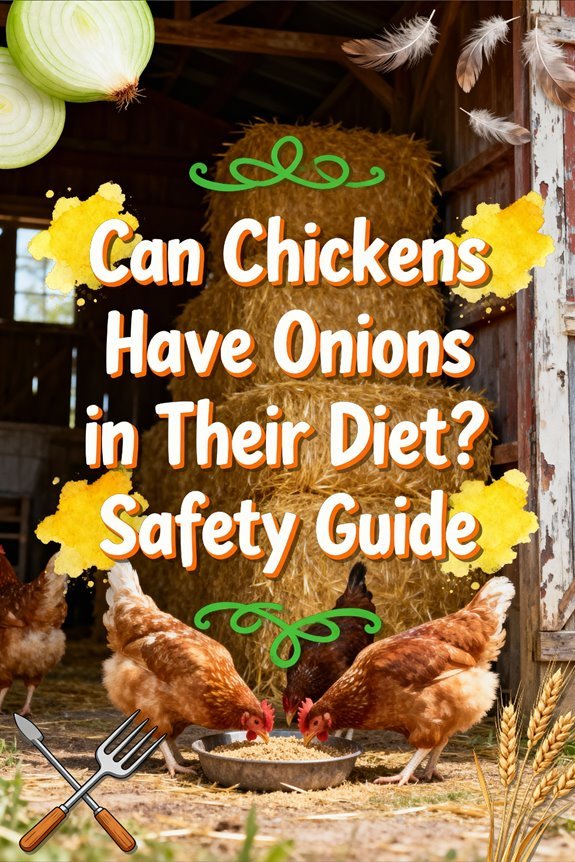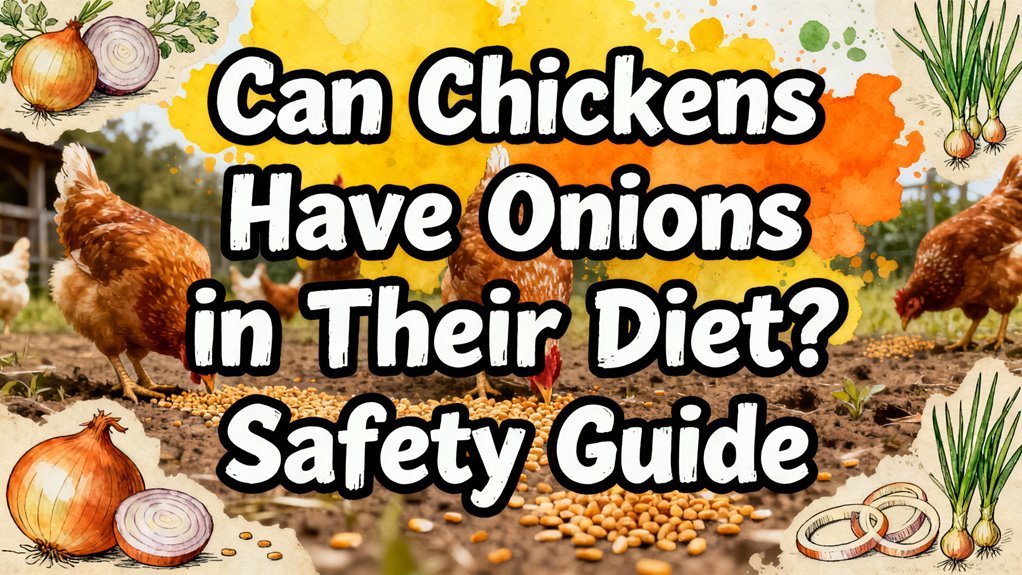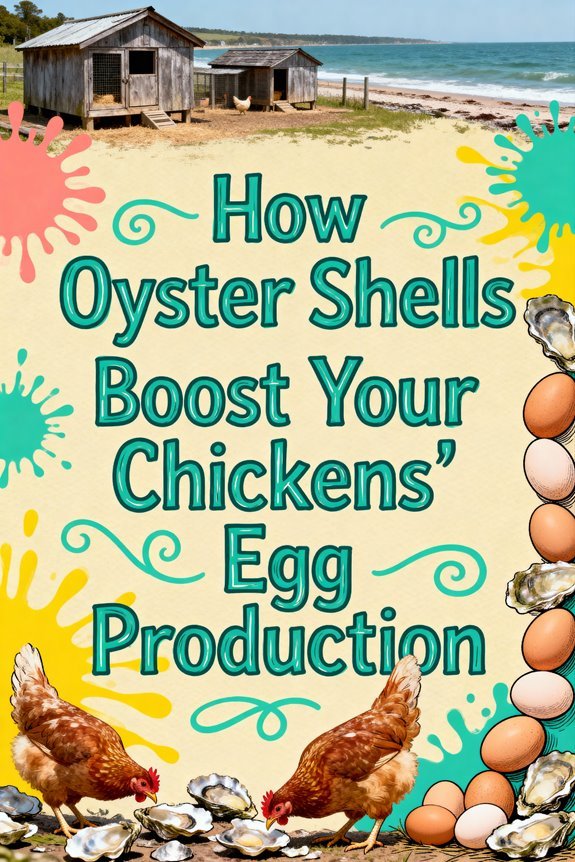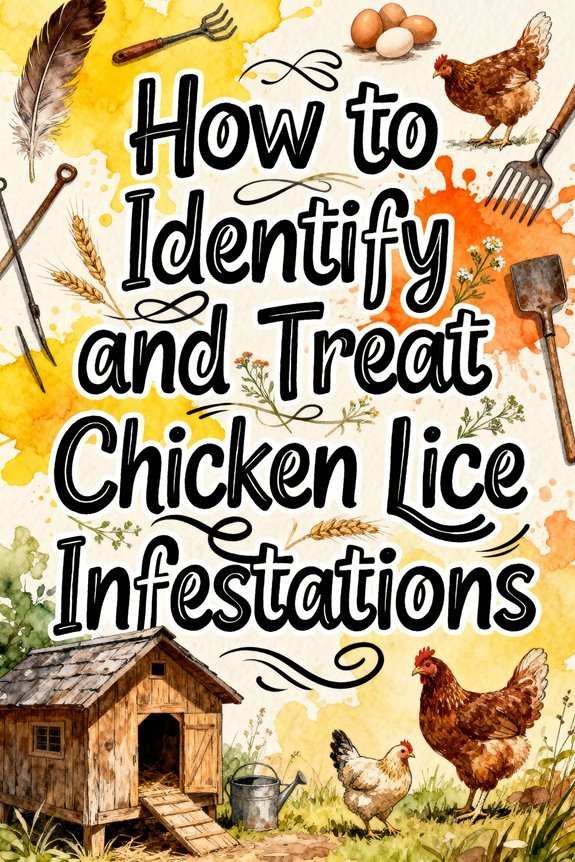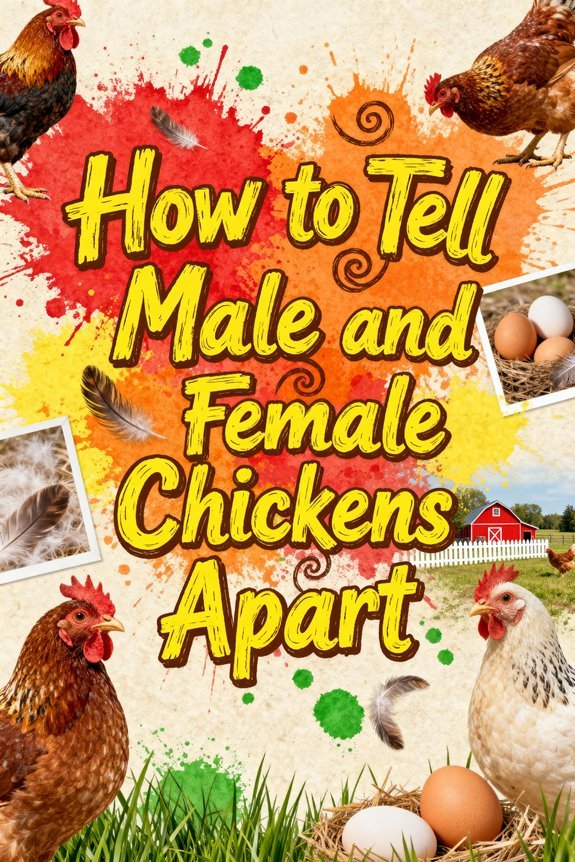Can Chickens Have Onions in Their Diet? Safety Guide
You should never feed onions to your chickens, as they contain toxic compounds like thiosulphate that cause severe hemolytic anemia by destroying red blood cells. All forms of onions – raw, cooked, or processed – pose serious health risks to your flock. Other Allium family vegetables, including garlic, leeks, and shallots, are equally dangerous. Watch for symptoms like lethargy, pale combs, and dark urine. Understanding proper nutrition and toxic foods will help protect your flock’s health.
The Hidden Dangers of Onions for Chickens
Although onions are a common kitchen staple, they pose serious health risks to chickens due to their toxic compounds, particularly thiosulphate and organosulfur compounds. When your chickens consume onions, these compounds trigger a dangerous chain reaction in their bodies, attacking and destroying red blood cells. This onion ingestion risk leads to hemolytic anemia, severely compromising your flock’s oxygen transport system.
Like raw green potatoes, onions can cause severe digestive and neurological issues in chickens. The poultry health impacts manifest through several critical symptoms you’ll need to watch for: lethargy, respiratory distress, pale combs and wattles, and diarrhea. What’s particularly concerning is that toxicity can develop from either a single large dose or repeated small exposures over time. The entire allium family, including leeks, chives, shallots, and garlic, contains these harmful compounds that can damage your chickens’ health. Similar to toxic plants like foxglove and hemlock, onions should be completely removed from areas accessible to your flock. In extreme cases, excessive consumption of onions can result in chicken mortality, making prevention absolutely crucial.
Understanding Thiosulphate Toxicity in Poultry
When thiosulphate enters a chicken’s system, it initiates a complex cascade of oxidative damage that specifically targets red blood cells. You’ll see the first signs of thiosulphate effects within 24 hours, though peak damage typically occurs around 72 hours after exposure.
The oxidative damage creates Heinz bodies – destructive hemoglobin inclusions that compromise your chicken’s oxygen transport system. Additionally, thiosulphate induces methemoglobinemia, further reducing the blood’s oxygen-carrying capacity. Even small amounts of onion can trigger these dangerous blood disorders in chickens. You’ll notice symptoms like pale combs, lethargy, rapid breathing, and weakness as the anemia progresses.
Laboratory tests can confirm toxicity through blood smear examination, revealing irregular red blood cell morphology and Heinz body formation. While there’s no specific antidote, early veterinary intervention with supportive care is essential for survival.
Warning Signs of Onion Poisoning in Your Flock
Recognizing onion poisoning symptoms early can make the difference between life and death for your chickens. Watch for initial onion toxicity symptoms like lethargy, reduced appetite, vomiting, and diarrhea within the first 12 hours to 5 days after consumption. Just as protective netting helps shield young chicks from predators, quick recognition of symptoms helps safeguard your flock’s health.
As anemia develops, you’ll notice your birds’ combs and wattles becoming pale or yellow. They’ll show weakness, breathe faster, and may have an elevated heart rate. Look for reddish urine, which indicates red blood cell destruction. The toxic compound N-propyl disulfide causes this dangerous breakdown of red blood cells. Instead of harmful onions, consider offering sulfur compounds found in broccoli which can actually support immune health when fed in moderation.
In advanced cases, you’ll observe yellowing of the skin and eyes, collapse, and uncoordinated movements. Monitor your flock’s feed intake and watch for early signs of respiratory distress. If you suspect onion poisoning, track symptoms carefully and seek immediate veterinary care, as the condition worsens progressively without treatment.
Other Harmful Allium Family Vegetables
Beyond onions, several other members of the Allium family pose serious health risks to chickens. Common vegetables like garlic, leeks, shallots, and scallions contain dangerous thiosulfates that can damage your flock’s red blood cells. Garlic dangers include reduced feed intake, digestive stress, and potential anemia, even though small amounts might offer some antimicrobial benefits. Leek toxicity manifests similarly, causing oxidative damage that can lead to weakness and lethargy in your birds. The compound N-propyl disulfide breaks down red blood cells rapidly when consumed. You’ll need to avoid these vegetables in all forms – raw, cooked, or processed. Even ornamental allium species carry the same risks. Toxic sulfur compounds can alter the taste of eggs from chickens that consume these vegetables. While other vegetable families like nightshades present different toxic effects, alliums specifically target blood cells and can accumulate harmful effects over time. Instead of alliums, chickens thrive on balanced protein diets supplemented with fresh vegetables and occasional healthy treats.
Impact on Egg Quality and Flavor
Although onions can be toxic to chickens, controlled supplementation with onion extracts shows notable effects on egg characteristics. You’ll find that onion supplementation can increase egg weight and improve shell quality, particularly shell thickness and strength. This enhanced shell durability reduces breakage during handling and transportation. Similar to oregano’s immune benefits, certain compounds in onions can support overall chicken health when used carefully.
Just as mixed flock housing requires careful monitoring, you’ll need to evaluate the impact on egg flavor. Sulfur compounds from onions can transfer to eggs, potentially creating off-flavors or an “onion taste” that sensitive consumers might detect. While onion supplementation can boost hen productivity by about 0.3% and increase egg mass by 0.5g/day through improved gut health and nutrient absorption, you’ll have to balance these benefits against possible flavor alterations. The threshold between beneficial supplementation and negative flavor impact remains unclear and requires careful monitoring. Since the chickens are 12 weeks old, any potential flavor changes won’t be observable until they begin laying eggs.
Safe Alternative Treats for Your Chickens
While onions pose risks to chickens, numerous safe and nutritious treats can enrich their diet. You’ll find nutrient-rich vegetables like broccoli, carrots, and kale offer essential vitamins and minerals, while squash family vegetables provide additional health benefits, including pumpkin seeds’ natural deworming properties. For protein sources, you can offer dried mealworms, crickets, or cooked eggs to support feather growth and egg production. Mealworms are especially beneficial during molting seasons when chickens require extra protein for feather regrowth. Fruits such as watermelon, strawberries, and seedless grapes deliver hydration and energy, though you’ll need to moderate these due to sugar content. Swiss chard and lettuce are excellent hydrating leafy greens packed with essential minerals. You can also incorporate plain yogurt for digestive health and sunflower seeds for essential fatty acids. Offering whole grain oats provides a nutritious alternative that supports overall chicken health. Remember to avoid nightshade family vegetables, except fully ripe tomatoes, and remove any toxic seeds or pits from fruits.
Emergency Response to Onion Exposure
If you suspect your chickens have consumed onions, immediate action is crucial for their survival. Contact your veterinarian immediately while monitoring your birds for signs of weakness, pale combs, jaundice, or reddish-brown urine, which typically develop within days of ingestion.
Emergency procedures focus on preventing further toxin absorption and supporting essential functions. While inducing vomiting isn’t practical in chickens, your vet may recommend activated charcoal administration. As onions are 3-5 times less potent than garlic, treatment options include oxygen supplementation, blood transfusions for severe anemia, and IV fluid therapy to protect kidney function. Just as a secure chicken run helps prevent accidental exposure to toxic foods, quick veterinary intervention helps prevent severe complications. Much like Anatolian Shepherds protect flocks from predators, a rapid medical response safeguards chickens from internal threats.
Monitor your chickens’ respiratory rate, heart rate, and behavior closely. Your vet will likely perform blood tests to measure hematocrit levels and check for Heinz bodies, confirming hemolytic anemia. Post-recovery monitoring guarantees proper healing and identifies potential complications.
